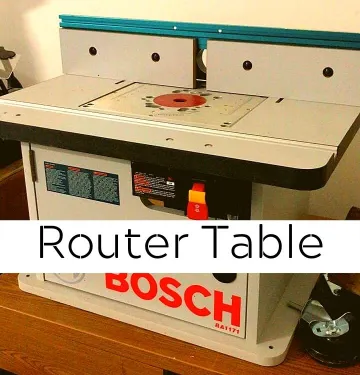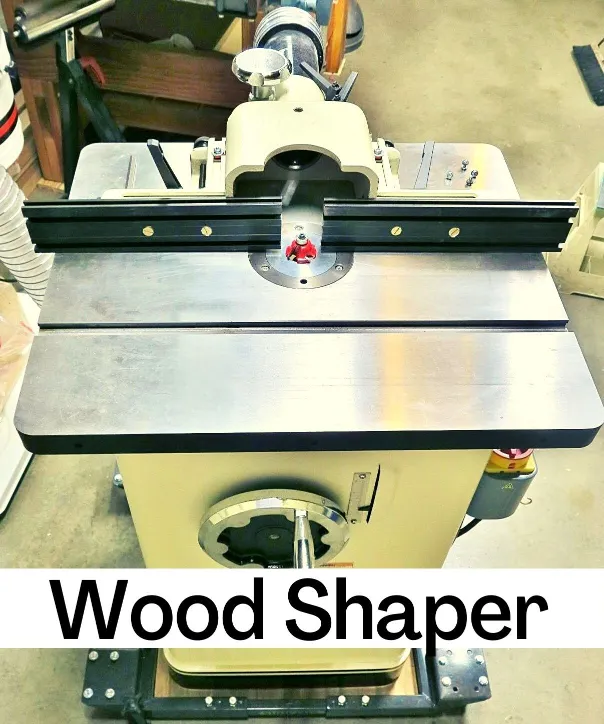By looking at these two apparatuses side by side, it’s easy to get confused between them and decipher something visibly distinct. However, as similar as they may appear, their features are very different, and both have individual qualities that the other can’t carry out.
If you’ve ever had a hard time telling the difference between the two, then you’ll be relieved to know that you’re just one of the innumerable woodworkers who don’t know the key variations of wood shaper vs router table.
Thanks to our team of researchers, we’re able to bring you the following info on the main differences and similarities between a wood shaper and a router table. So, let’s get into the facts.
Is the Router Table Same as a Router?
Wood router, routing tool, or just router are all various names referring to the same thing. It’s a power tool used for a multitude of woodworking tasks, from everything to round overs to profiling edges. Routers come in different sizes as well, including trim routers, a middle-sized router, and larger ones.
The base is set onto the actual router part that is adjusted according to the desired depth of the cut. On the router part, there is a steel sleeve that’s meant to hold a router bit, known as a collet. Collets come in a variety of sizes, too, all meant to fit into the wide range of different router bits.
To get to know the basics of shapers, learn more here.
A router table is different from a router only because — you guessed it — it’s a table. It’s stationary, and the actual router is within the machine while the spindle, or collet holding the router bit, sticks out of the table.

It allows the tool to work upside down, allowing one to run wood over the top of the machine. An inverted router allows the user to do so while still keeping the tool balanced on the table. Routers can get various types of woodwork done.
Is a Router Table Better Than a Router?
Handheld routers can be risky. They don’t provide the precision and efficiency a router table can give you. Also, there’s the added risk of having to keep your hands steady at all times to get a clean cut.
Router tables provide stability, precision, and support to your router, which in turn makes for the best passes on wood. They’re sturdy and stationary, so they definitely leave very little space for mistakes.
However, router tables can take up both space in your working area and money. This is often the reason why most woodworkers build their own router tables. Plus, you might be better at freehand routing than with a table, so the choice is essentially up to you.
Wood Shaper vs. Router Table – Differences and Similarities
Both these get mistaken for each other time and time again. This can be troublesome, as their qualities set them apart from each other a lot when it comes to woodworking. So, it’s about time we make things clear between the two.
Here are some things you should know about wood shapers vs. router tables:
Differences
- Cutters
Router tables have routing tools that use a variety of cutters, depending on the user’s choice. These cutters, usually called router bits, have a shaft that’s permanently built into them and are used to secure onto the router’s spindle for precise cutting.
The sizes of these cutter shafts can vary, but the most common are half or a quarter-inch in diameter.
On the other hand, shapers use cutters that don’t include shafts but rather a hole with grooves. And since it’s a wood shaper, the cutters are no longer called “bits” like they are in routing tools. Wood shaper cutters are much larger than router bits and can go up to thrice the size.
This large size also comes with a reasonably heftier price tag.
- Power
Router tables are great for making raised panels, beveling edges, and leveling uneven wood. However, with prolonged use or too many passes, these routing tools can catch smoke. This is why professional woodworkers use router tables for light work only and switch to wood shapers for heavy-duty tasks.
Wood shapers are ideal for heavy-duty jobs like door making. By optimizing the cutting motion and eliminating the need for numerous passes at the router table, they may extend the life of their equipment. This is, of course, due to the highly efficient spindle and large diameter of the cutter.
If you have experience working on both wood shapers and router tables, you might already know that the single pass on a shaper is triple or more than the passes on a router table. This is all because of the difference in the capacity of the motors.
- Cutting Direction
While wood shapers allow reversible cuts, routers lack this feature and can cut only one way. This might not be that big of an issue and not that noticeable either, but in times when you need to make a reverse pass, routers can make it difficult.
One of the most common reasons why to reverse the direction of a cut is to prevent tear-out. With a reverse shaper, all that’s needed is to flip the cutter upside down and reverse its rotation. This eliminates the need for a switch to turn the motor.
This feature in wood shapers comes in handy when the grain direction of the wood varies and requires a pass in the opposite direction rather than the conventional right to left mechanism. Plus, this allows you to run cuts such as rail-and-stile or raised panels face up or face down, depending on which is best for the job.
- Speed
This might come off as a bit surprising, but even with the router’s high affinity to light woodwork rather than heavy-duty, it still has a much faster speed compared to wood shapers.
A wood shaper bit is typically faster than a router bit in terms of completing large projects. This is because it has a higher level of power, which allows it to complete more complex tasks.
Similarities
- Structure
Wood shapers and router tables have one visible similarity, which is why people often mix them up, and that is their structure.
They are both tables with motor-powered tools in them. Both wood shapers and router tables have their main component (shaper or router) inside the table, with its spindle protruding out of the surface. However, shapers come with a split fence that increases the accuracy of cuts.
Both wood shapers and router tables look similar, but as you already know, they are very different in functionality.
- Cuts
Both wood shapers and routers can be used to make similar cuts, such as raised panels. The motor type is the only thing that sets the cuts apart, as routers cannot take as many passes as shapers can.
But, this all comes back to you at the end. Routers and shapers are both excellent cutting tools, just with varied capabilities.
Wood Shaper vs Router Table: Which One’s Worth It?
As we’ve discussed before, both wood shapers and router tables are great for making precise cuts. All that sets them apart is how much the user expects out of them.
If you’re looking to do heavy-duty woodwork, shapers are the way to go. But simple precision cuts that don’t require many passes should be more than enough with a router table.
A wood shaper will often take up more room than a router table; however, this is not always the case. So, you might need to take the space of your working area into consideration when settling between the two.

Another factor to consider is the cost. Wood shapers are more expensive than routers because of their higher versatility. Furthermore, wood shaper bits and accessories are more costly than router bits and accessories. But, they are a great tool to have in your woodworking station nonetheless.
Frequently Asked Questions
1. Can you use router bits in a shaper?
Router bits have built-in shafts that are permanent, while shapers have cutters that are hollow with grooves. Cutters of a shaper are much bigger compared to router bits. Although some router bits may be able to fit the shaper, it isn’t the best idea to use them because they’re meant for routing tools.
2. Can I use a router as a shaper?
Routers have greater speed than shapers but with much less power, which can cause them to catch smoke if they are overburdened with stock. It’s better to stay on the safe side and use shapers for the heavy-duty stuff and routers for the light work.
3. Can you use a router table to cut wood?
A router is not the same as a saw, it may be used to cut wood, although not in the same manner as a jigsaw can. Routers will have guides or fences for accuracy when it comes to edge work, whereas saws are used freehand.
4. Why is a shaper better than a router?
Shapers and routers have their own unique functionalities, they are not better than the other apart from their compatibility with the user’s woodwork of choice. In terms of power, shapers have a more efficient motor than routers, whereas routers have a higher RPM.
5. Can a router be used freehand?
Yes, freehand routers are often used by professional carpenters. However, it’s best to opt for a table if you’re a beginner since it provides accuracy and leaves little space for mistakes.
So, who wins the wood shaper vs router table battle? It fully depends on what you expect from a cutting tool. Both of these tools are great in their own way, and there’s no way to say which is better than the other. But, we hope we’ve made it clear how these two differ.
